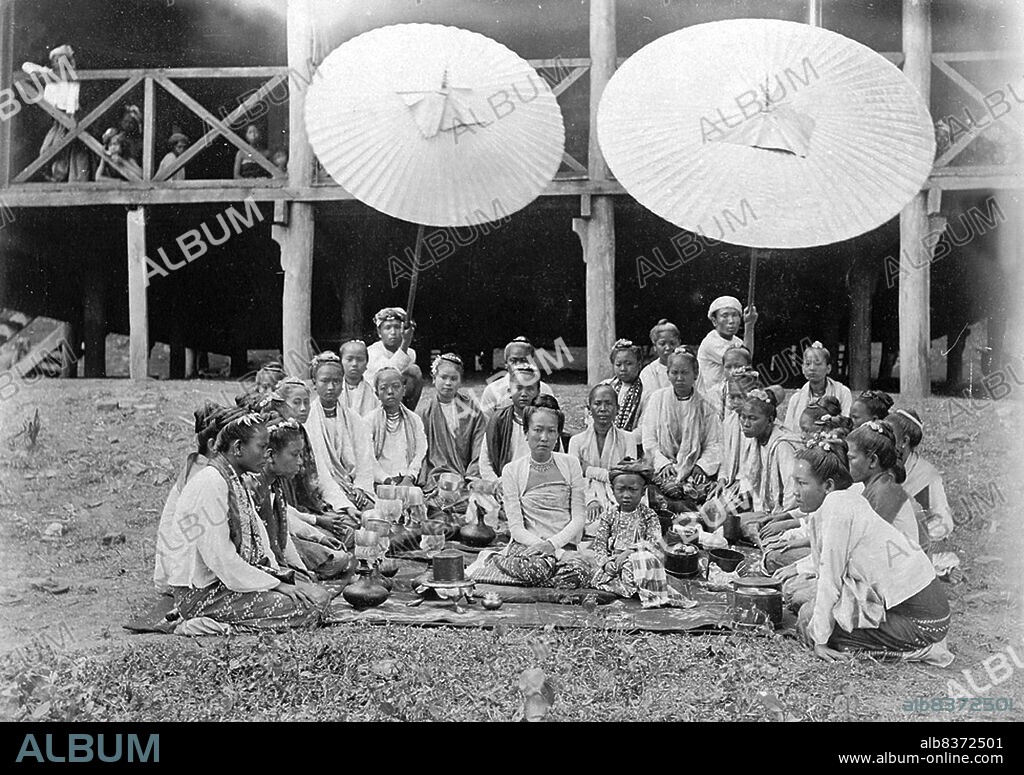alb8372501
Burma / Myanmar: The wife and son of Maung Aung Myat (1857-c. 1910), the Shan saopha< / i> or feudal lord of Wuntho, Felice Beato, c. 1891

|
Add to another lightbox |
|
Add to another lightbox |



Buy this image.
Select the use:

Title:
Burma / Myanmar: The wife and son of Maung Aung Myat (1857-c. 1910), the Shan saopha< / i> or feudal lord of Wuntho, Felice Beato, c. 1891
Caption:
Photograph of a Sawbwas wife and child at Wuntho in Burma (Myanmar) from the Elgin Collection: 'Autumn Tour 1898', taken by Felice Beato c.1891. The portrait was taken in front of a house at Wuntho, showing the wife and child of the Wuntho Sawbwa, a Shan feudal lord, seated on the ground with food baskets. Attendants are arranged around the pair in a semi-circle and two servants hold umbrellas over the group.
. The woman wears a striped silk hta-mein (wrap-around skirt), a close-fitting jacket of fine muslin or cotton known as an ein-gyi, and necklaces. During the Konbaung Dynasty (1752-1885), rich jewellery, fine fabrics such as silk, and garments such as her jacket were reserved for court officials and their wives by sumptuary laws. After the fall of the Burmese monarchy they were worn by the wealthy.
. Wuntho or Waing Hso was a native state of Upper Burma when Burma (Myanmar), was under British control. It had an area of around 6,200 square kilometres (2,400 sq mi) with 150,000 inhabitants and lay midway between the Ayeyarwady and Chindwin rivers.
. The woman wears a striped silk hta-mein (wrap-around skirt), a close-fitting jacket of fine muslin or cotton known as an ein-gyi, and necklaces. During the Konbaung Dynasty (1752-1885), rich jewellery, fine fabrics such as silk, and garments such as her jacket were reserved for court officials and their wives by sumptuary laws. After the fall of the Burmese monarchy they were worn by the wealthy.
. Wuntho or Waing Hso was a native state of Upper Burma when Burma (Myanmar), was under British control. It had an area of around 6,200 square kilometres (2,400 sq mi) with 150,000 inhabitants and lay midway between the Ayeyarwady and Chindwin rivers.
Credit:
Album / Universal Images Group / Pictures From History
Releases:
Model: No - Property: No
Rights questions?
Rights questions?
Image size:
5000 x 3525 px | 50.4 MB
Print size:
42.3 x 29.8 cm | 16.7 x 11.8 in (300 dpi)
Keywords:
1891 • ASIA • ASIAN • BURMA • BURMESE • CHAOFA • CLOTHES • CLOTHING • CLOTHINGS • COSTUME • DISGUISE • DRESS • DRESSED • FELICE BEATO • FEMALES • GARMENT • HABIT • INDIA • INDIAN • INDIGENOUS PEOPLES OF THE AMERICAS • INDIO • INDUMENTARIA • KING • LORD (NOBILITY) • LORD • MASQUERADE • MAUNG AUNG MYAT • MONARCH • MUJER • MYANMAR • PHOTOGRAPH • ROBE • RULER • SAOPHA • SAWBWA • SHAN STATE • SHAN • SUIT • TAI YAI • WOMAN'S • WOMAN • WOMEN'S • WOMEN • WOMENS • WUNTHO • ZHAO
 Pinterest
Pinterest Twitter
Twitter Facebook
Facebook Copy link
Copy link Email
Email
